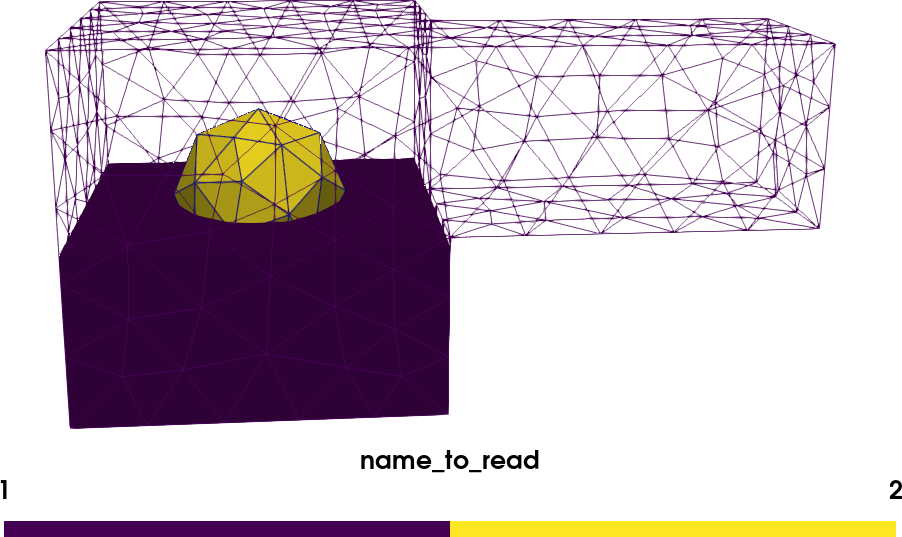
To create the square, four points are speficied and these are connected by four lines.

For this tutorial, a square shape is first created. The shape to be meshed will be created by specifying points and then connecting these points with lines.
GMSH .MSH SAMPLE FILES HOW TO
So I hope you get an idea how to use Meshx, If you are working with FEniCS.The first step in creating a mesh is to create some shape that will be meshed. TETHEX, examples which illustrate the use of TETHEX, a C++ program which can read a Gmsh file defining a mesh of triangles or tetrahedrons, and subdivide the mesh into quadrilaterals or hexahedrons, which are suitable for use by the DEALII finite element program, by Mikhail Artemiev. # Define new measures associated with the interior domains andĭx = Measure ( "dx" )( subdomain_data = domains ) ds = Measure ( "ds" )( subdomain_data = boundaries ) #-į = ( inner ( a0 * grad ( u ), grad ( v )) * dx ( tags ) + inner ( a1 * grad ( u ), grad ( v )) * dx ( tags ) - g_L * v * ds ( tags ) - g_R * v * ds ( tags ) - f * v * dx ( tags ) - f * v * dx ( tags )) MSH, a data directory of examples of MSH files, the native 3D mesh format used by Gmsh. Then, from the left hand bar, select Modules > Mesh > 2D and this should produce a triangular and fairly homogeneous surfacic mesh. You may also choose to decrease your element size to obtain a courser or finer mesh. The ordering of the vertices implies the orientation of the panel normal, following the same conventions as the WAMIT. # Define Dirichlet boundary conditions at top and bottom boundariesīcs = ), DirichletBC ( V, 0.0, boundaries, tags )] #- Open this file in Gmsh, and select Tools > Options and set your 2D algorithm to MeshAdapt. It is able to read one single Gmsh file stored under the msh v4 format which contains both. With result, the gmsh file size is very large. MeshFunctionSizet ( mesh, mvc_2 ) # creating mesh function for surface The GmshIO plugin is developed on top of Gmsh 4.7 public APIs. I can even export result to gmsh and view the result from there. read ( mvc_2, "tag" ) print ( "Constructing MeshFunction from MeshValueCollection" ) domains = cpp. With XDMFFile ( "mesh/triangle.xdmf" ) as infile : print ( "Reading 2d surface data into dolfin mvc" ) infile. MeshFunctionSizet ( mesh, mvc_1 ) # creating mesh function for curve read ( mvc_1, "tag" ) print ( "Constructing MeshFunction from MeshValueCollection" ) boundaries = cpp. As per thread on, gmshToFoam can convert only version 2 of Gmsh format. load ( f ) with XDMFFile ( "mesh/line.xdmf" ) as infile : print ( "Reading 1d line data into dolfin mvc" ) infile. The syntax is gmshToFoam case.msh -case oFCase. All you need is add this lines: Mesh.Format 1 // msh output format Mesh.MshFileVersion 2.2 // Version of the MSH file format to use Into. Using this mode, gmsh will always save in msh format 2.2. Leaving this unchecked exports only cells which have been labelled in your. m file making sure you do not check the export all cells button - this forces all cells to be exported in a merged fashion. Just put this Mesh.MshFileVersion 2.2 into. For a GMSH output to work properly, I found you need to use coherence and make sure each cell is labelled. #import the json file so that tag names can be usedį = open ( 'mesh/tags.json' ) tags = json. gmsh meshtest.geo -2 -format msh2 Script. Gmsh is built around four modules: geometry, mesh, solver and post-processing. Its design goal is to provide a fast, light and user-friendly meshing tool with parametric input and advanced visualization capabilities.
GMSH .MSH SAMPLE FILES GENERATOR
Mvc_2 = MeshValueCollection ( "size_t", mesh, 2 ) #for surface with dim 2 Gmsh is an open source 3D finite element mesh generator with a built-in CAD engine and post-processor. Mvc_1 = MeshValueCollection ( "size_t", mesh, 1 ) #for curve with dim 1 Finally, recompute the geometry, export the part to the STEP file and save the document in FreeCAD format (not. Mesh = Mesh () with XDMFFile ( "mesh/triangle.xdmf" ) as infile : infile. msh file and use the following command to convert. The MSH ASCII file format contains one mandatory section giving information about the file. msh as an extension for mesh file, but it > doesn't mean that the format of the files is the same (open both with a text > editor to see the. > Hi Javier, > I suppose Gambit and Gmsh use. The main usage is a 2d mesh, generated for example with Gmsh, that is read in from a.

msh, but Gmsh is not able to open it (even though it opens >.msh). Open the temrinal and go to the folder containing the. It is a quite big file, with around 500000 cells and 34 Mb.


 0 kommentar(er)
0 kommentar(er)
